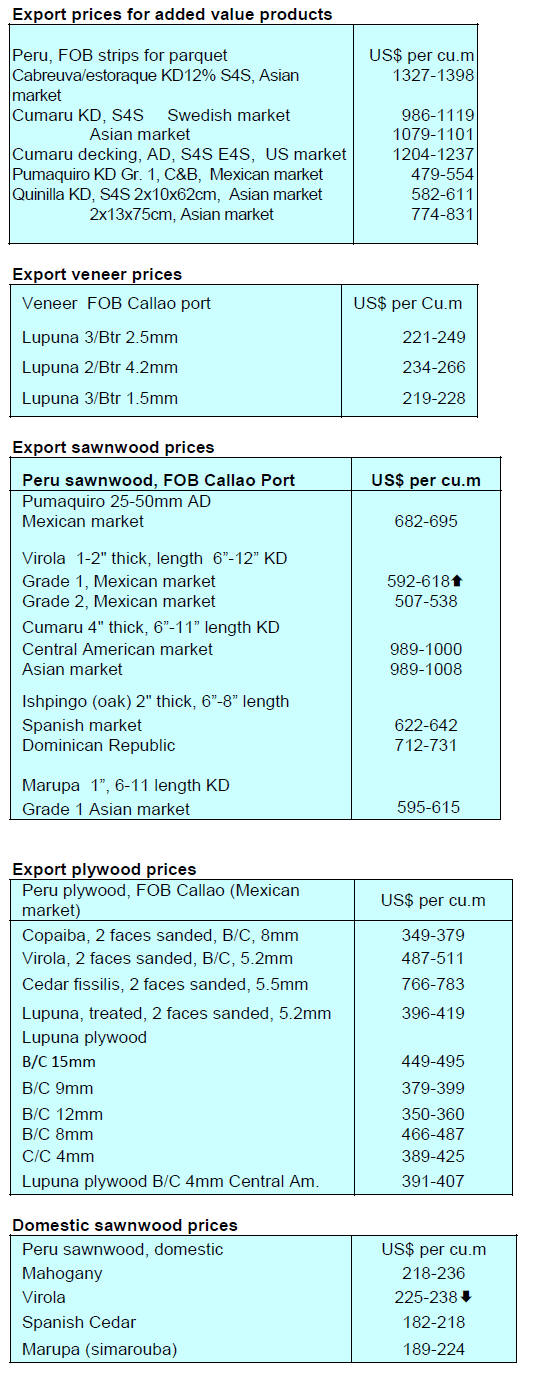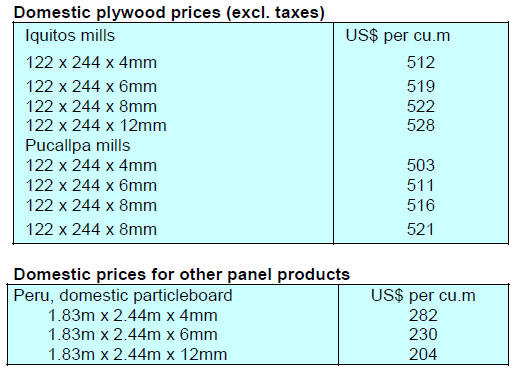4.
INDONESIA
New export record
Despite uncertain global economic conditions exports of
Indonesian wood products in 2022 continued to grow.
Data from the Ministry of Environment and Forestry
(KLHK) analyses by the Association of Indonesia Forest
Concession Holders (APHI) show Indonesia's exports of
wood products in 2022 reached US$14.51 billion. This
was a significant increase in export values compared to
2021 which were recorded at US$13.56 billion.
The export value for wood products in 2022 was a record
surpassing the previous record in 2021. In 2022 paper
products contributed the most to export earnings at
US$4.37 billion, up 18% yoy followed by wood pulp
US$3.73 billion, up 15% yoy. The other wood products
that made a large contribution were wood panels US$2.86
billion and furniture worth US$2.26 billion.
See:
https://forestinsights.id/2023/01/27/nilai-ekspor-produkkayu-melompat-7-persen-catat-rekor-baru-sepanjang-sejarah/
Market diversification - biomass trade with EU member
states
Markets such as Bulgaria, Lithuania, Slovenia and other
Eastern European countries are to be the target for
expanded wood product exports in the EU.
In addition to the current products exported such as paper,
panels and furniture efforts will be made to export wood
pellets according to the chairman of the Association of
Indonesia Forest Concession Holders (APHI), Indroyono
Soesilo. He added there is a skyrocketing demand for
Indonesian wood products in Eastern European member
States.
In Bulgaria there was a 100% increase in Indonesian wood
product exports, a 400% increase in Croatia, 125% in
Lithuania and a massive jump in exports to Slovakia.
However, currently the volumes are small but there are
opportunities for growth. Indroyono said growth in nontraditional
market countries is an opportunity to increase
exports amidst the economic challenges of 2023.
See:
https://forestinsights.id/2023/01/31/pasar-non-tradisionaljadi-incaran-indonesia-tingkatkan-ekspor-kayu-ke-uni-eropabiomassa-potensial-digarap/
and
https://agroindonesia.co.id/peningkatan-ekspor-produk-kayuindonesia-bidik-pasar-non-tradisional-di-uni-eropa/
Indonesian furniture for Swiss market
The Minister of Cooperatives and SMEs, Teten Masduki,
has pointed out that, as a results of discussion with the
Swiss Secretariat for Economic Affair, an Indonesia-
Switzerland FTA had been ratified which will benefit
businesses in both countries.
As a follow-up the Minister suggested members of the
Indonesian Furniture and Craft Industry Association
(Asmindo) take advantage of the import duty exemption
built into the FTA.
See:
https://www.neraca.co.id/article/175077/asmindo-didorongmanfaatkan-fasilitas-pembebasan-bea-masuk-ke-swiss
Government to encourage downstreaming of 21
commodities
The Indonesian government’s investment policy will
remain focused on investment in downstream
manufacturing in 21 commodity sectors in order to attract
investment worth over US$500 billion by 2040 according
to the Minister for Investment, Bahlil Lahadalia. The
ministry has prioritised investment needs of 8 sectors
namely minerals, coal, oil, natural gas, plantations, marine,
fisheries and forestry. The 8 sectors cover 21
commodities: coal, nickel, tin, copper, bauxite, steel, gold,
silver, asphalt, oil, natural gas, coconut, rubber, biofuel,
logs, pine resin, shrimp, fish, crab, seaweed and salt.
See:
https://en.antaranews.com/news/271980/govt-todownstream-21-commodities-minister
No leniency for private firms on forest fires
At a press conference on “Preparedness for 2023 Forest
and Land Fires” Environment and Forestry (LHK)
Minister, Siti Nurbaya Bakar, emphasised that the
government will take firm action against businesses found
causing forest fires in Indonesia. She is reported as saying
"if forest fires happen because of the private sector there
will be no mercy because as soon as a hotspot is detected
as we will immediately act.
See:
https://en.antaranews.com/news/270738/no-leniency-forprivate-firms-on-forest-land-fires-minister
In related news, the President urged regional military and
police chiefs to develop forest fire preparedness in their
respective jurisdictions. Th President highlighted that the
police and the military are responsible for taking forest
and land fire prevention efforts in line with the pledge they
had made years ago. He called for concerted action in
forest fire-prone areas including Riau, North Sumatra and
Kalimantan.
See:
https://nasional.tempo.co/read/1689073/jokowi-bilangancaman-copot-pangdam-kapolda-soal-kebakaran-hutan-masihberlaku
UNDP Funding for Climate and Sustainable Forest
Management
Indonesia has received a first disbursement of US$46
million from the US$103.8 million approved by the Green
Climate Fund (GCF), following the success in emission
reduction from Indonesian forestry sector in the period
2014 to 2016.
The United Nations Development Programme (UNDP)
has transferred the funds to the Indonesian Environment
Fund (IEF) which has a mandate to manage environment
funds. The IEF was officially formed to channel
environmental and climate funds to support achievement
of Indonesia’s Nationally Determined Contribution (NDC)
commitments to achieve net-zero emissions by 2060 by
reducing Green House Gas (GHG) as part of the global
mandate and commitment to combat climate change.
See:
https://www.undp.org/indonesia/press-releases/indonesiareceives-usd-46-million-its-stewardship-climate-action-andsustainable-forest-management
ADB to support rural livelihood and agroforestry
The Asian Development Bank (ADB) signed a US$15
million loan facility with PT Dharma Satya Nusantara Tbk
(DSNG) to help the company expand sustainable wood
processing, rural livelihood development and climateresilient
agroforestry in Java. The ADB money will be
used to implement energy-efficient and water-saving
processes and procurement of cultivated native Indonesian
Sengon and Jabon saplings.
DSNG sources timber from Central, East and West Java.
The majority of Sengon and Jabon trees are cultivated by
smallholders and are inter-cropped with coffee, corn and
rice. As well as enabling the utilisation of otherwise
unproductive land, intercropping trees with food crops can
reduce erosion, enhance soil health and in many cases
improve crop yields.
See:
https://www.devdiscourse.com/article/business/2333576-adb-signs-15m-loan-with-dsng-to-support-rural-livelihood-andagroforestry-in-indonesia

5.
MYANMAR
No indication logging ban will
continue
The Ministry of Natural Resources and Environmental
Conservation (MONREC) announced a logging ban in a
mini-budget for 2021-22 and for 2022-23. There has been
no announcement of a logging ban for 2023-24. However,
MONREC has indicated harvesting will be less than
Annual Allowable Cut (AAC).
See -
https://www.independent.co.uk/news/martial-law-apmyanmar-bangkok-yangon-b2274606.html
Uncertainty looms over Myanmar economy: World
Bank
Myanmar’s economy remains subject to significant
uncertainty with ongoing conflict disrupting businesses
according the World Bank ‘Myanmar Economic Monitor’
published this year. It says, while some firms show signs
of resilience, household incomes remain weak and
Myanmar’s potential for growth has been severely
weakened.
Mariam Sherman, the World Bank’s country director said
“while conflict remains, families suffer from insecurity
and violence. Firms, particularly those in the agriculture
sector, are experiencing higher costs and delays”.
The World Bank expects that a gradual economic recovery
could be seen in the near term and growth is estimated at
3% year ending in September. However, economic activity
continues to be adversely affected by conflict, electricity
shortages and changing regulations, with per-capita gross
domestic product expected to remain about 13% below
pre-Covid levels.
The depreciating kyat, high global prices and ongoing
logistics constraints have caused import costs to rise
sharply and these shocks fuel inflation and further reduce
real incomes, said the report.
“Losses in education along with increased unemployment
and internal displacement will reduce already low levels of
human capital and productive capacity over the long term
the report says.
The report recommends a more unified and marketoriented
foreign exchange system which would help
stabilise the economy, reduce inflation and remove market
distortions.
See:
https://www.worldbank.org/en/country/myanmar/publication/myanmar-economic-monitor-reports
Martial declared in many areas
Martial law was declared in several areas a day after
authorities announced that a state of emergency has been
extended throughout the country which is wracked by
violence.
State-run MRTV television broadcast an announcement by
the State Administration Council (SAC), imposing martial
law in 37 townships across eight of the country’s 14
Regions and States.
Eleven of the affected townships are in Sagaing Region
and seven in Chin State, areas in the northwest where
fighting has been fiercest between the army and people
belonging to pro-democracy People’s Defense Forces and
their allies. Most of areas identified in the statement are
timber producing areas.
See:
https://www.aa.com.tr/en/asia-pacific/myanmar-militaryjunta-declares-martial-law-in-37-more-townships/2805072
Sanctions affect everyone
The local media has highlighted the impact of
international sanctions on businesses and households
saying while the international economic sanctions target
the current military-led government everyone is affected.
There are shortages, costs are climbing, development aid
has been cut, trade has been cut and investment has
slowed. To adjust to the new economic reality the
government restricts imports to try and balance foreign
currency earnings and outgoings.
In stark contrast to the reality the Prime Minister, General
Min Aung Hlaing, said at a meeting last year that if
Myanmar makes efforts it will reach the middle income
level among ASEAN countries in the next 5 years.
See -
http://burmese.dvb.no/archives/577628
6.
INDIA
Strong economy not reflected in rupee
exchange rate
According to a Reuters poll of foreign exchange strategists
the rupee is likely to strengthen only slightly in coming
months and will still trade above the 80 to the US dollar
all year.
Although India is a fastest growing emerging economy
that relative strength is not reflected in the exchange rate
movements. Underlying economic problems, including a
reliance on imported oil and persistent unemployment
continue to hold down the exchange rate.
Title
The real estate industry fears the recent interest rate rise
announced by the Reserve Bank of India (RBI) will harm
the housing industry. The real estate sector believes that
the increased rate will push upthe cost of servicing home
loans at a time when the sector has begun showing
promising sales numbers. The decision by the RBI will
lead to higher borrowing costs which could again reduce
the demand for home loans.
However, on the positive side real estate industry
stakeholders in Bengal are of the opinion that the state
government’s rebate on stamp duty will have some
positive impact on the housing market in the short term.
The Monetary Policy Committee of the RBI increased
interest rates in a bid to arrest retail inflation.
Anuj Puri, chairman of property consultancy ANAROCK
Group is quoted as saying “The Indian housing market
continues to be largely end-user driven -- and end-users,
unlike investors, focus less on return on investment and
more on the perceived value of home ownership.
Furthermore, commodity prices are now falling and
inflation is moderating. As such, we are unlikely to see
any hikes in the near future, which will be positive for the
housing sector in times to come.”
See:
https://www.millenniumpost.in/bengal/rbis-65-hike-in-reporate-bound-to-impact-indias-housing-market-508051
Launch of the ‘Trees Outside Forests in India’
In a press release the Government of Rajasthan’s Forest
Department and the U.S. Agency for International
Development (USAID) announced the launch of the
“Trees Outside Forests in India (TOFI)” programme in
Rajasthan which will bring together farmers, companies
and other private entities to rapidly expand tree coverage
outside of traditional forests in the state.
The new initiative will enhance carbon sequestration,
support local communities and strengthen the climate
resilience of agriculture, thereby supporting global climate
change mitigation and adaptation goals.
See:
https://www.usaid.gov/india/press-releases/feb-07-2023-government-rajasthan-and-usaid-launch-new-initiative-increasetree-coverage-rajasthan
Green bonds to lower borrowing cost
For the first time the Reserve Bank of India (RBI) issued
sovereign green bonds on behalf of the Government of
India. The initial announcement was made by Union
Finance Minister, Nirmala Sitharaman, in her 2022 budget
speech. The government had later announced it would
issue such bonds worth Rs.16,000 crore this year as part of
the overall market borrowing programme.
There are investors who are willing to accept
comparatively low returns to support green
initiatives. Some institutional investors are also mandated
to invest in such instruments. Corporations engaged in
green businesses can secure funds at relatively low rates.
A lower cost of borrowing would help Asia’s third-largest
economy finance infrastructure and meet clean energy
goals, while managing a record debt issuance plan. The
first green bond sale will take place before the end of the
fiscal year in March and discussions are underway with
ministries to identify projects.
See:
https://economictimes.indiatimes.com/industry/renewables/indiais-counting-on-debut-green-bond-to-cut-financingcosts/articleshow/94193033.cms


Plywood
Ex-warehouse prices for plywood have been increased to
compensate for the higher costs of logs and resins used in
manufacturing. Last month the North India Plywood
Associations advised its members to charge 7% extra from
their dealers to compensate for the rising production costs.
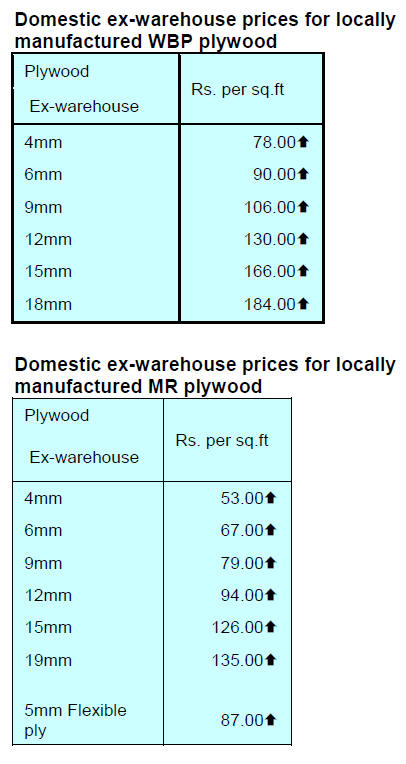
7.
VIETNAM
Wood and Wood Product (W&WP) Trade highlights
According to the Vietnam General Department of Customs
W&WP exports in December 2022 were US$1.3 billion,
up 11.5% compared to November 2022, but down 8.4%
compared to December 2021. WP exports, in particular,
accounted for US$875 million, up 15% compared to
November 2022 but down 19% compared to December
2021.
In 2022 W&WP exports were valued at US$16 billion a
year-on-year growth of 8%. Of this WP exports
contributed US$11.04 billion, down 0.3% compared to
2021. Exports of wooden furniture in December 2022
were valued at US$798.6 million, down 19% compared to
December 2021. In 2022 exports of wooden furniture
totalled at US$10 billion, down 0.4% over the same period
in 2021.
W&WP exports to the US in December 2022 stood at
US$678 million, down 19% compared to December 2021.
In 2022, the total W&WP exports to the US amounted to
US$8.7 billion, down 1.3% compared to 2021.
Vietnam's imports of logs and sawnwood in December
2022 were 440,200 cu.m, worth US$157.2 million, down
9% in volume and 8% in value compared to November
2022. Compared to December 2021 however, imports
increased by 17% in volume and 7% in value.
In 2022 imports of raw wood were reported at 5.993
million cu.m equivalent to US$2,270 billion, down 4% in
volume, but up 5% in value compared to that of 2021.
Vietnam's tali wood imports in December 2022 reached
57,900 cu.m,, worth US$23.2 million, up 8% in volume
and 8% in value compared to November 2022. Compared
to December 2021, tali imports increased by 203% in
volume and 211 % in value.
In 2022 tali imports totalled 557,300 cu.m, worth
US$226.0 million, up 46% in volume and 44% in value
compared to 2021.
Imports of logs and sawnwood from the US in December
2022 experienced the fourth consecutive monthly decline
and stood at 44,160 cu.m, at a value of US$19.19 million,
down 18% in volume and 22% in value. In 2022 imports
of logs and sawnwood from the US to Vietnam totalled at
689,430 cu.m, worth US$327.11 million, up 0.8% in
volume and 3% in value compared to 2021.
Vietnam’s W&WP exports increased by 8.1% in 2022
Over the last 10 years Vietnam's W&WP exports have
been increasing steadily. The mean growth in the period
2012 - 2022 is calculated at 14% per year. Growth was
fast in 2018, 2019 and 2020 and surprisingly in 2021,
amid the Covid-19 pandemic, exports grew nearly 20 %.
However, by 2022, the growth rate of W&WP exports
slowed as the value of exports was US$16 billion, up just
8% compared to 2021.
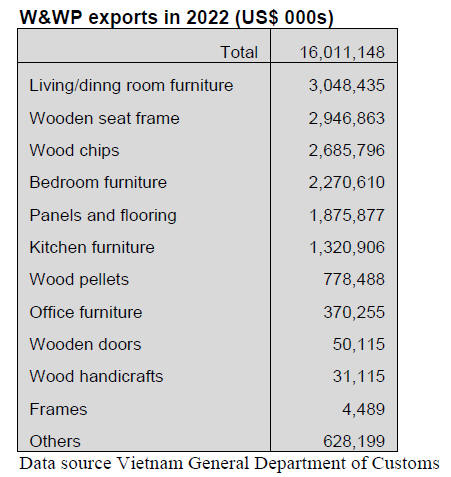
Forecasts and suggestions for manufacturers
from
VIFOREST
Vietnam’s wood sector has been targeting 5 major
markets; the US, Japan, China, South Korea and the EU.
The current global situation and problems facing these
markets for W&WP from Vietnam can hardly give an
optimistic forecast on Vietnam’s W&WP trade.
According to Vietnam Wood and Forest Products
Associations (VIFOREST) the growth of W&WP exports
in 2023 is expected to be up between 7% - 9% year on
year far below the growth rate over the last 10 years. With
this expected growth W&WP exports in 2023 will be
between US$17 billion - 17.5 billion. To face the
downturn in the major markets Vietnamese traders have
been advised by VIFOREST to adopt the following
measures and solutions:
expand utilisation of domestic wood raw
materials to reduce input costs
apply improved technologies to enhance labor
productivity
apply digital transformation to reduce production
costs
promote low-emission production
coordinate with localities to build specialised
wood processing and trading zones in various
regions of the country
enhance W&WP trade promotion with attention
given to attending international trade fairs for
wood products, wood technologies and wood
manufacturing machines
diversify export markets and increase customer
outreach through improving designs, focusing on
high-value commodity groups, opening trade
representation in key markets
utilise of the advantages gained from the Free
Trade Agreements Vietnam has concluded with
important trade partners
8. BRAZIL
Instilling responsibility in young
entrepreneurs
The “Amazon Journey” initiative aims to promote
businesses that support the maintenance of tree cover. The
initiative is also called "the Genesis Program" being aimed
at young talents to encourage research oriented towards
products and processes that have a minimal impact on the
forest.
The initiative is coordinated by the Certi Foundation in
collaboration with participation and investments from
Bradesco, Fundo Vale, Itaú-Unibanco and Santander,
partners in the Amazon Plan, an alliance among the three
banks and Vale's Bioeconomy Program Fund.
The programme will bring together young people from the
nine states of the Legal Amazon to debate local
opportunities, market demands, in addition to the
socioeconomic and environmental sustainability of the
Amazon rainforest. The main topics will be biotechnology,
innovation ecosystem, impacting business.
The Genesis programme is a launch pad for a second stage
“Synapse Program” which seeks to help entrepreneurs get
their idea off the ground. In 2022, a programme was held
in Pará state with 516 young people resulting in 105 new
ideas for entrepreneurial solutions for a bio-economy
agenda in the Legal Amazon.
See:
https://epocanegocios.globo.com/um-soplaneta/noticia/2023/02/programa-vai-formarempreendedores-que-apoiem-floresta-amazonica.ghtml
Forestry careers on offer
The domestic and international demand for pulp and paper
produced in the state of Mato Grosso do Sul encouraged
companies increase recruitment and offer training. In
2023, through on-site and distance courses, some 2,145
new employees were trained.
A large pulp and paper company located in Três Lagoas
municipality, State of Mato Grosso do Sul, has more than
5,300 workers, 2,900 of them work on forest operations.
Another pulp and paper company, in Ribas do Rio Pardo
municipality, in the same State partnered with SENAI
(National Service for Industrial Training) to conduct
training. The company plans to recruit 2,000 people by
2024 for forest operations.
See:
http://www.remade.com.br/noticias/18917/em-altano-mato-grosso-do-sul--carreira-florestal-e-protagonistaem-2023
UAE/Brazil Business Council
In 2022 the Brazilian Furniture Project took many member
companies on a trade mission during Expo Dubai and attracted
more than US$2.8 million in immediate business and US$15.6
million in potential orders.
Between 2006 and 2021 Brazil exported around US$60.3 million
in furniture to the UAE. This was a period in which there was
57% growth. Brazilian exports to the UAE jumped from US$6.9
million in 2017 to US$10.8 million in 2021.
In 2022 the CNI (Brazilian National Confederation of Industry)
and the FCCI (Federation of Chambers of Commerce and
Industry of the United Arab Emirates) established the United
Arab Emirates/Brazil Business Council to strengthen trade and
investment between the two countries.
See:
http://abimovel.com/exportacao-de-moveis-e-colchoesoportunidades-para-a-industria-brasileira-nos-emirados-arabes/
2022 not a great year for the Bento Gonçalves furniture
cluster
2021 was a year of atypical growth in revenue and exports
for companies in the Bento Gonçalves furniture cluster, in
the state of Rio Grande do Sul with export demand surging
as people focused on furnishing their homes during the
COVID-19 pandemic.
In 2022 even when life in the US started to return to
normal sales of durable goods such as furniture lost
momentum and this resulted in a decline in export
earnings for the 300 Brazilian manufacturers.
Companies in the Bento Gonçalves furniture cluster ended
2022 with R$3.1 billion in revenues and US$54.5 million
exported, a decrease of 3% and 28%, respectively
compared to 2021 according to SEFAZ (Secretariat of
Finance), Comex Stat and CAGED (General Register of
Employed and Unemployed Workers). The slowdown in
sales also resulted in job losses with employment in the
sector dropping over 2%.
According to the Furniture Industry Union of Mato Grosso
State (SINDMÓVEIS) it is projected that demand will
remain stable in 2023 with the possibility of a slight
increase of 2% to 3% in the cluster's revenues. In 2022,
despite the declining export earnings, there was success in
diversifying markets. Products from the region were
exported to 59 countries, a 15% increase compared to
2019, the year prior to the COVID-19 pandemic. The top
10 export destinations were the United States, Uruguay,
Chile, the United Kingdom, Peru, Mexico, Colombia,
Paraguay, Puerto Rico, and Panama.
See:
https://emobile.com.br/site/industria/balanco-do-polomoveleiro-de-bento-goncalves-em-2022/
‘Through the eyes of industry’, challenges and
suggestions from Brazi and Mexico
See:
https://www.ittoggsc.org/static/upload/file/20230214/1676340295137619.pdf
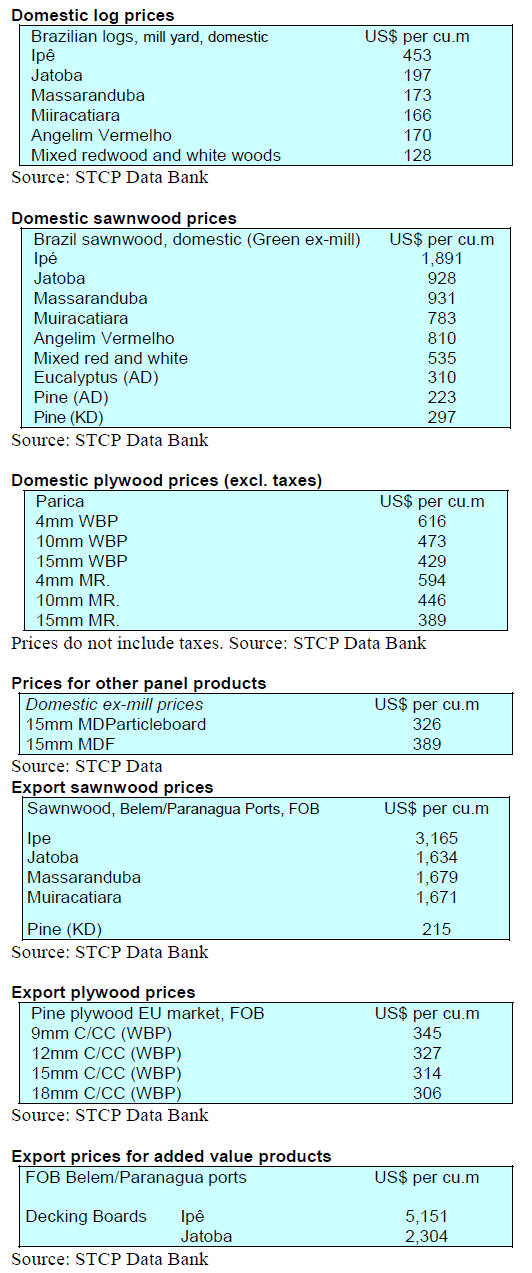
9. PERU
Guidelines for SERFOR audits of timber
producers and
exporters
The National Forest and Wildlife Service (SERFOR) has
approved "Guidelines for conducting audits and
verification of producers and exporters of timber forest
products". These guidelines establish the provisions for
SERFOR or the Regional Forest and Wildlife Authorities
(ARFFS) to conduct periodic audits of producers and
exporters of timber forest products.
The aim is to verify compliance with the obligations for
international trade as established in Law No. 29763,
Forestry and Wildlife Law and in the Trade Promotion
Agreements signed by Peru.
Increase in particleboard imports
The value of Peruvian imports of particleboard reached
US$161.9 million in 2022 (versus US$159.5 million in
2021). This was a record and a 1.6% year on year growth.
Ecuador, once again, was the main supplier to Peru during
2022 with shipments worth US$70.7 million which
represented an increase of 4% compared to 2021. Spain
was the second ranked supplier with US$35.1 million, a
9% drop compared to the US$38.6 million shipped to Peru
in 2021.
Forest fire prevention campaign
SERFOR in coordination with the Provincial Municipality
of Satipo, started the campaign for the prevention of forest
fires in the Central Jungle (Amazonía del Perú) area of the
country.
The Technical Administrator of the ATFFS-Central Forest
said he objective of this technical assistance is to promote
the preparation of fire prevention action plans to reduce
the risks of forest fires. The initial training highlighted the
importance of disaster risk management in the country.
Peruvian exports in 2022 grew 4%
The Association of Exporters (ADEX) has reported
Peruvian export shipments in 2022 at US$63,193 million,
up 4% year on year despite five months of declines during
the year the deepest being those of the last quarter
(October -6 %, November -19% and December -8%).
After growing 8%, 23% and 8% in 2016, 2017 and 2018
respectively, in 2019 and 2020 export earning dropped
-2% and -11% to reverse to expand 48% in 2021, the
rebound after the easing of covid responses in the US and
the EU.
ADEX president, Julio Pérez Alván, expressed his concern
about prospects for January this year as production and
supply chains have ben disrupted due to civil unrest. He
added “There is tension and concern for the welfare of
workers, damage to private property and trust with
international buyers”.
Exports of primary products in 2022 totalled US$44,914
million the leading sub-sector was mining with US$35,032
million, down -7% due to political-social unrest.
In second place was hydrocarbons (US$6,151 million),
followed by fishing (2%) and agriculture (57%).
Despite lower demand (-2%) China was the top export
market followed by the US and Japan. Other markets in
the top five were Canada and South Korea.
